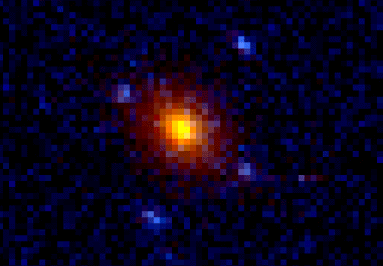Explanation: Sometimes it takes a keen eye to see a good mirage. Around the center of the red galaxy image in the above photograph lie four blue "smudges." Each smudge is actually a different image of the same background quasar. The central galaxy happens to fall directly in the light path of the quasar. Consequently, the huge mass of the galaxy is able to pull separate images of the quasar around it - an effect called gravitational lensing. Hence we see a gravitational mirage! Astronomers have hopes of using light differences between these quasar images to not only "weigh" the central galaxy but even provide clues about the expansion rate and composition of the universe.
1999 2000 2001 2002 2003 2004 2005 2006 2007 2008 2009 2010 2011 2012 2013 2014 2015 2016 2017 2018 2019 2020 2021 2022 2023 2024 2025 |
Yanvar' Fevral' Mart Aprel' Mai Iyun' Iyul' Avgust Sentyabr' Oktyabr' Noyabr' Dekabr' |
NASA Web Site Statements, Warnings, and Disclaimers
NASA Official: Jay Norris. Specific rights apply.
A service of: LHEA at NASA / GSFC
& Michigan Tech. U.
|
Publikacii s klyuchevymi slovami:
gravitational lens - gravitacionnoe linzirovanie - kvazary - dalekie galaktiki
Publikacii so slovami: gravitational lens - gravitacionnoe linzirovanie - kvazary - dalekie galaktiki | |
Sm. takzhe:
Vse publikacii na tu zhe temu >> | |
